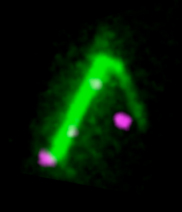
For a mother cell to divide its genetic material equally between the two daughter cells, the chromosomes have to attach to microtubules, which will pull them apart. The linkers between chromosomes and microtubules are kinetochores, protein complexes on the chromosome. The key question is how microtubules find kinetochores. According to the pioneering idea termed search-and-capture, numerous microtubules grow in all directions and by chance capture kinetochores. Researchers at the MPI-CBG, MPI-PKS, and the University of Zagreb discovered a new mechanism of kinetochore capture. They showed that kinetochores are captured by microtubules rotating around the spindle pole, instead of growing towards the kinetochores.
The experiments revealed that microtubules swipe through the cell and thus explore space while searching for kinetochores. This search strategy is cost-effective for the cell, because it requires only a small number of microtubules and does not need energy from ATP. Mathematical modelling confirmed that the swiping movement of the microtubules facilitates kinetochore capture. Thus, the new search mechanism discovered by the MPI researchers challenges the paradigm of chromosome capture introduced in the 1980s.
Iana Kalinina, Amitabha Nandi, Petrina Delivani, Mariola R. Chacón, Anna H. Klemm, Damien Ramunno-Johnson, Alexander Krull, Benjamin Lindner, Nenad Pavin, and Iva M. Tolić-Nørrelykke:
Pivoting of microtubules around the spindle pole accelerates kinetochore capture
Nature Cell Biology, published online 9 December 2012